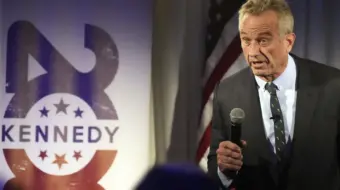Who is counting your vote? Now is the time, before November 2004, to ask that and a few other questions.
Dr. Martin Luther King Jr., whose birthday we celebrate Jan. 19, was a courageous fighter for voting rights. He wrote an op-ed piece in the New York Times, Sept. 14, 1965, as Congress was debating the Voting Rights Act of 1965.
“In Selma, Alabama, thousands of Negroes are courageously providing dramatic witness to the evil forces that bar our way to the all important ballot box,” King wrote.
Those same “evil forces” are alive and well today, although they have found more efficient methods than poll taxes and phony literacy tests to disenfranchise voters.
Computerized voting seems to be a good thing at first glance. It is easier, right? Easy or not, computer technologists and voting-rights advocates are now sounding the alarm: Just who owns the machines? Can they be programmed to help the right wing continue their vote stealing racket so vividly displayed in the stolen 2000 presidential election?
An Aug. 28, 2003, Cleveland Plain Dealer article quoted Walden O’Dell who said he is “committed to helping Ohio deliver its electoral votes to [George W. Bush] in 2004.” O’Dell is the chairman of the board of Diebold Election Systems, the second largest company in the U.S. that counts votes … our votes. O’Dell is also a member of the Rangers and the Pioneers, those who have contributed the most money to the Bush campaign.
On occasion, O’Dell hangs out at the Bush ranch in Crawford, Texas. He hosted a $600,000 fundraiser for the Bush-Cheney campaign in Ohio in which Cheney was the featured speaker. Questions began to swirl about Diebold’s vote-counting machines soon after they began securing lucrative contracts under George W. Bush’s “Help America Vote Act” (HAVA), which provides $3.9 billion to the states to help finance a total shift to so-called direct-recording electronic (DRE) voting by 2006.
HAVA also provides funding for computerized voter rolls, including programs for removal of “ineligible” voters. It is modeled on the vote scrubbing operation carried out by Database Technologies and its parent company, ChoicePoint, in the 2000 election under a multi-million dollar contract signed by then-Florida Secretary of State Katherine Harris. Tens of thousands of mostly African American and Latino voters were improperly removed from the Florida voting rolls, key to George W. Bush’s theft of the election.
Critics discovered a web site set up by Global Elections Systems (GES) that was taken over by Diebold in 2002. It contained thousands of sensitive files on the hardware and software of the touch screen machines. It proved just how vulnerable they are to tampering and vote falsification.
Diebold sought an injunction to block circulation of the memos on grounds of copyright infringement. But Swarthmore College students had posted the memos on dozens of sites on the Internet. Democratic presidential candidate Dennis Kucinich hosted the memos on his web site. Diebold has since withdrawn the lawsuit.
Bev Harris, who has since written a book, “Black Box Voting: Ballot Tampering in the 21st Century” (available free from the site www.blackboxvoting.org), received 7,000 of the Diebold documents. Among them was a memo by GES employee Lana Hires to her supervisor during the 2000 election: “I need some answers,” she writes. “Our department is being audited by the county. I have been waiting for someone to give me an explanation as to why Precinct 216 gave Al Gore a minus 16,022 votes when it was uploaded. Will someone please explain this so that I have the information to give the auditor instead of standing here ‘looking dumb?’”
Over the past 30-40 years, where voting machine irregularities have come to light, those irregularities have “overwhelmingly favored Republican candidates.” In 2002, 74 percent of upset elections were called in favor of Republicans.
A Nov. 7, 2002, Associated Press story datelined Snyder, Texas, reported, “A defective computer chip in the county’s optical scanner misread ballots Tuesday night and incorrectly tallied a landslide victory for Republicans.” Poll workers became suspicious. As a result of those workers’ inquiry, a new computer chip was flown to Snyder, Texas, from Dallas. Once the new chip was installed, the computer verified that the Democrat had won the election. The question remains: Was this an innocent computer glitch or something far more sinister, an attempt to steal that election for the Republicans?
In a July 30, 2003, article published by Alternet.org titled, “The Theft of Your Vote is Just a Chip Away,” writer Thom Hartmann reported on another “Texas anomaly.” In the November 2002 election in Comal County, Republican state Sen. Jeff Wentworth won with 18,181 votes, Republican Carter Casteel won a state House seat with 18,181 votes, and Judge Danny Scheel (a conservative) won his race with 18,181 votes. All three in the same county, same day, same year, all three with exactly the same number of votes. However, no poll workers in the county asked for a new chip.
A key criticism of some touch screen machines is that they leave no paper trail, there is no record for the voters to see of the votes cast. The process has been described as voting into a “black box.”
Georgia and the strange defeat of incumbent Democratic Sen. Max Cleland in the 2002 election is a clear example. An Atlanta Journal-Constitution poll showed Cleland with a 49-44 percent lead over Republican Rep. Saxby Chambliss the week before the election. Cox News Service (Atlanta-based) said, “Pollsters must have goofed.” Chambliss was declared the winner by 53-46 percent.
This was an election marked by almost unimaginable Republican viciousness. Chambliss ran television ads savaging Cleland, a triple amputee Vietnam vet, as an “enemy” of George W. Bush’s “war on terrorism.” Why? Cleland had voted against Bush’s Homeland Security Act on grounds that it strips federal workers of their union rights.
Chambliss was trailing Cleland in every public opinion poll leading up to the election. Similarly, Republican Sonny Perdue was declared winner over Georgia’s incumbent Democratic Gov. Ray Barnes, 52-45 percent, despite a Mason Dixon poll prior to the election showing the Democrat with a 48-39 percent lead a month before the election.
Pundits opined that the stunning Republican upset victories were the result of George W. Bush’s barnstorming visits to the state as well as a backlash by white men angry that the Confederate flag had been abolished as the state banner. Yet, post-election polls showed there had been no such angry surge among white male voters in Georgia.
Suspicious Georgia citizens began investigating. Anecdotal reports by voters revealed that breakdowns of the Diebold machines had been widespread. In heavily Democratic Fulton County, which includes Atlanta, 67 memory cards were mislaid for 10 days and in neighboring DeKalb County, 10 memory cards were lost. State officials cannot affirm that the votes on these “mislaid” cards were ever counted.
Andrew Gumbel of the British Guardian, who observed the election, writes, “The vote count (in Georgia) was not actually conducted by state election officials but by the private company that sold Georgia the voting machines in the first place under a strict trade-secrecy contract that made it not only difficult but actually illegal – on pain of stiff criminal penalties – for the state to touch the equipment or examine the proprietary software to ensure the machines worked properly. There was not even a paper trail to follow up.”
Let’s look at Minnesota. What happened in the race to have former Vice President Walter Mondale voted into the U.S. Senate seat vacated by the death of Sen. Paul Wellstone? A Star Tribune poll on Oct. 30, 2002, reported Democrat Mondale leading Republican Norm Coleman 47-39 percent. When the vote was counted, Coleman won by 50-47 percent of the vote. Was there a sudden surge of Republicanism in Minnesota? No one asked for a new computer chip.
Who owns your voting machines? Three corporations – Election Systems and Software (ES&S), Diebold, and Sequoia Voting Systems – own the hardware and software used to count about 80 percent of the votes cast electronically in the U.S.
Both ES&S and Diebold are owned by Republican partisans. ES&S is owned by the Omaha World Herald Company, a company with solid ties to the Republican Party. Sequoia’s owner is De La Rue, based in Great Britain. Sequoia counted more votes in the California recall election than any other company. De La Rue is the world’s largest commercial security printer and papermaker.
Arthur Andersen Co. is to count Internet military votes. According to Landes, the Internet voting business is dominated by two corporations. One is Accenture (whose corporate offices are located in Bermuda) and the other is VoteHere (Seattle). “The U.S. Department of Defense recently awarded a coalition of corporations, led by Accenture, the contract to provide Internet service that will count the votes of the U.S. military and some civilians in the 2004 presidential election.” Nearly 6 million voters may be affected. “Accenture was formerly known as Andersen Consulting, a subsidiary of Arthur Andersen.” Yes, the same company convicted of destroying evidence in the Enron crime. One of Accenture’s most important business partners is Halliburton.
Admiral Bill Owens is the chairman of VoteHere, the world’s leading supplier of Internet voting software. Owens is a former high-level military assistant to former Secretaries of Defense Frank Carlucci and Vice President Dick Cheney. Also sitting on the VoteHere Board of Directors is Robert Gates, an ex-CIA director once tripped up in the Iran-Contra scandal. Carlucci (also of the Carlyle Group and a business partner of former President George H.W. Bush) was former Secretary of Defense in the Reagan administration and a Deputy Director of the CIA in the Carter administration. Carlucci is also on the advisory board of Populex, which is producing electronic voting systems for Illinois.
A striking fact about the boards of these companies is the presence of former CIA directors, including James Woolsey, Bobby Ray Inman, John Deutch, and Gates and Carlucci. When has the CIA been pro-democracy? Why this keen interest in voting technology?
Privately-held companies are in the business of counting our votes. So who monitors them? The National Association of State Election Directors (NASED). NASED is tied closely, according to Landes, to the election industry. There is no enforcement by the U.S. Department of Justice.
Private companies cite “security and competition” reasons as to why they can’t divulge every aspect of their vote-counting procedures. Those procedures and techniques have raised eyebrows and suspicions.
What is to be done? The 2004 elections are already upon us. Take a group of friends, call and go to your County Board of Elections. Ask if your machines have paper trails. Who makes the machines?
Voting machines must not be privatized. Those who would profit from skewing elections against the working class should not own the machines. The voting apparatus should be publicly owned and operated. There should be no “trade secrets” in place to ensure that a voting machine company won’t have to tell us how the machines operate.
Harvard University’s Rebecca Mercuri, a voting machine expert, had it about right: “If you want to make Coca-Cola and have trade secrets, that’s fine, but don’t try to claim trade secrets when you’re handling our votes.”
Rep. Rush Holt (D-N.J.) is sponsoring the “Voter Confidence and Increased Accountability Act of 2004” (HR-2239), which calls for paper ballots, surprise recounts and auditable software in voting machines. But some critics say it doesn’t go far enough. The critical issue is to keep the vote directly in the hands of the voters. The election laws in some countries require that as many ordinary people as possible be permitted into the room where the votes are tallied.
The U.S. right wing, frightened as usual into skullduggery and violence by any whiff of democracy, knows well that it can’t win if it does not cheat. Now is the time to look at your voting machines. Better now than after Election Day 2004.
The author can be reached at bjhope215@yahoo.com. Tim Wheeler contributed to this story.











Comments